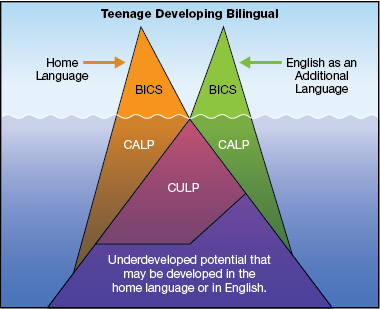Understanding the Acquisition of English as an Additional Language
|
← Back to Using Iceberg Models Scenario 3: Teenage English Language LearnersViktoriya and her brother Nikolay immigrated to Canada from Russia with their parents when they were 12 and 14 years old, respectively. Both had limited knowledge of English when they arrived, but they leveraged their well-developed proficiency in Russian to acquire English rapidly. Now in high school, they both have made good progress in acquiring both social and academic English (BICSBICS (basic interpersonal communicative skills): simple, functional language for communicating basic needs, ideas, and opinions and engaging in everyday conversations in informal social situations and CALPCALP (cognitive academic language proficiency): language required to understand and communicate about abstract concepts and accomplish a wide-range of cognitively demanding academic tasks, including reading textbooks, writing essays, and doing research). Their proficiency in English is still not as well developed as in Russian, but they continue to make steady progress in English. At this point, it’s the occasional errors that Viktoriya makes when speaking that remind people that English is not her first language because by now she has almost no accent. Because he was older when he began learning English, Nikolay has an accent. However, he is just as easy to understand as Viktoriya when he speaks English. There is another noticeable difference between Viktoriya and Nikolay related to language acquisition. Their parents have observed that Nikolay’s Russian vocabulary and language base has grown since they moved to Canada while Viktoriya speaks Russian the way she did when she came to Canada. Her Russian language proficiency largely ceased to develop when she began to learn English, whereas Nikolay’s language proficiency grew along side English. In Viktoriya’s case, Russian supported her acquisition of English. In Nikolay’s case, the two languages supported each other’s development. To become fully bilingual in English and Russian, Viktoriya and Nikolay need to continue to develop their proficiency in English as well as Russian. Viktoriya’s and Nikolay’s profile is commonly described as teenage developing bilingual, meaning they began developing proficiency in an additional language as young teenagers while maintaining or further developing proficiency in their home languagehome language: the dominant language that a student uses at home to communicate with family members. Although Viktoriya’s and Nikolay’s language acquisition profiles differ somewhat, they both fit the teenage developing bilingual model, which illustrates how teenagers learn an additional language with help from their home language.  This diagram illustrates a teenager who has primarily developed BICS and CALP skills in his or her first or home language. This is typical of a student who has been exposed to an additional language after 12 years of age. In the student’s home language, BICS is almost fully developed by this age, whereas the CALP shows development through education and there is still room to develop further. BICS is not fully developed in English, and it will take time to acquire common social conventions, expressions, and idioms. While these students can often achieve native-like fluency in English, many show some signs of first language interference or transfer. Academically, these students acquire English as an additional language more easily than students matching most other profiles described by the iceberg drawings: They use their CULP CULP (common underlying language proficiency) the language knowledge and skills that students develop as they learn one language that they can then use to help them learn other languages to transfer known language and concepts from their home language to English. These students often have the literacy skills in their home language that assist them in developing their literacy skills in English. Both languages will have to continue to develop if the student is to become bilingual. There is a risk that English will take over from the home language; thus, there is the risk that the home language will cease to develop. The student may maintain basic social and academic language in the home language, but there would be no further development in the home language. Implications for the Instruction of English Language Learners English language learners belonging to this profile are challenged in that they have not fully developed their home language before having to tackle demanding academic content in English, which they are still in the process of acquiring. As they arrive at school in the later grades, these students may find themselves under time pressure to acquire the English language skills and the academic knowledge required for graduation. These students benefit from sustained and targeted English language supports—in particular, assistance in building their academic vocabulary as rapidly as possible. |

